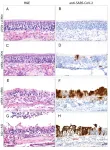(Press-News.org) If you’re an avid gardener, you may have considered peat moss — decomposed Sphagnum moss that helps retain moisture in soil — to enhance your home soil mixture. And while the potting medium can help plants thrive, it’s also a key component of peatlands: wetlands characterized by a thick layer of water-saturated, carbon-rich peat beneath living Sphagnum moss, trees, and other plant life.
These ecosystems cover just 3% of Earth’s land area, but “peatlands store over one-third of all soil carbon on the planet,” explains Joel Kostka, professor and associate chair of Research in the School of Biological Sciences at Georgia Tech.
This carbon storage is supported in large part by microbes. Two microbial processes in particular — nitrogen fixation and methane oxidation — strike a delicate balance, working together to give Sphagnummosses access to critical nutrients in nutrient-depleted peatlands.
The coupling of these two processes is often referred to as the “missing link” of nutrient cycling in peatlands. Yet, how these processes will respond to changing climates along northern latitudes is unclear.
“There are tropical peatlands — but the majority of peatlands are in northern environments.” notes Caitlin Petro, a research scientist who works with Kostka in Biological Sciences at Tech. “And those are going to be hit harder by climate change.”
Kostka and Petro recently led a collaborative study to investigate how this critical type of ecosystem (and the “missing link” of microbial processes that support it) may react to the increased temperature and carbon dioxide levels predicted to come with climate change. The team, which also includes researchers from the Oak Ridge National Laboratory (ORNL), Florida State University, and the University of Tennessee, Knoxville, just published their work in the scientific journal Global Change Biology.
By testing the effects of increasing temperature and carbon dioxide on the growth of Sphagnum moss, its associated microbiome, and overall ecosystem health, Kostka and Petro say computational models will be better equipped to predict the effects of climate change.
“Down the road,” Kostka added, “we hope the results can be used by environmental managers and governments to adaptively manage or geoengineer peatlands to thrive in a warmer world.”
Raising the heat
To see how northern peatlands will react to climate change, the team, which also included School of Earth and Atmospheric Sciences Associate Professor Jennifer Glass, turned to the ORNL Spruce and Peatland Responses Under Changing Environments (SPRUCE) experiment — a unique field lab in northern Minnesota where the team warms peat bogs and experimentally changes the amount of carbon dioxide in the atmosphere.
Starting in 2016, the team exposed different parts of SPRUCE’s experimental peatlands to a gradient of higher temperatures ranging from an increase of 0°C to 9°C, capturing the Intergovernmental Panel on Climate Change models’ predicted 4°C to 6°C increase in northern regions by 2100.
The moss’s reaction was significant. Although nearly 100% of the bog’s surface was covered in moss at the beginning of the experiment, moss coverage dropped with each increase in temperature, plummeting to less than 15% in the warmest conditions.
Critically, the two microbial processes that had previously been consistently linked fell out of sync at higher temperatures.
“Peatlands are extremely nutrient-poor and microbial nitrogen fixation represents a major nitrogen input to the ecosystem,” Kostka explained. Fixing nitrogen is the process of turning atmospheric nitrogen into an organic compound that the moss can use for photosynthesis, while methane oxidation allows the moss to use methane released from decomposing peat as energy. “Methane oxidation acts to fuel nitrogen fixation while scavenging a really important greenhouse gas before it is released to the atmosphere. This study shows that these two processes, which are catalyzed by the Sphagnum microbiome, become disconnected as the moss dies.”
“These processes occurring together are really important for the community,” Petro explained. Yet many microbes that are able to both fix nitrogen and oxidize methane were absent in the mosses collected from higher temperature enclosures. And while elevated carbon dioxide levels appeared to offset some of the changes in nitrogen cycling caused by warming, the decoupling of these processes remained.
“These treatments are altering a fairly well-defined and consistent plant microbiome that we find in many different environments, and that has this consistent function,” Petro explained. “It's like a complete functional shift in the community.”
Though it’s not clear which of these changes — the moss dying or the altered microbial activity — is driving the other, it is clear that with warmer temperatures and higher carbon dioxide levels comes a cascade of unpredictable outcomes for peat bogs.
“In addition to the direct effects of climate warming on ecosystem function,” Petro adds, “it will also introduce all of these off-shooting effects that will impact peatlands in ways that we didn't predict before.”
By: Audra Davidson
Photos and more info here.
END
Rising temperatures alter ‘missing link’ of microbial processes, putting northern peatlands at risk
2023-04-03
ELSE PRESS RELEASES FROM THIS DATE:
Maclean studying paid sick leave mandates & mental health care service use
2023-04-03
Catherine Maclean, Associate Professor, Schar School of Policy and Government, received $641,155 from the National Institutes of Health for: "Paid Sick Leave Mandates and Mental Healthcare Service Use."
This project will provide the first causal estimates of the effect of state and local paid sick leave (PSL) mandates on access to PSL among those with mental health disorder(s), use of mental health care, and indicators of potential quality of mental health care received. It will also examine how community-level factors (e.g., mental health ...
How two different types of immune cells help two billion people keep tuberculosis in check
2023-04-03
More than 10 million people are sickened by tuberculosis (TB) globally each year, resulting in 1.5 million deaths. Yet, as many as two billion people are infected with Mycobaterium tuberculosis, the bacterium that causes tuberculosis, and are otherwise healthy and asymptomatic. Scientists who study TB look at those individuals who can tolerate and contain the infection in hopes of developing better treatments and vaccines.
The key feature of tuberculosis infection in humans is the formation of granulomas, or clusters of immune cells in the lungs that contain the infection. These granulomas contain B cells, all-purpose immune cells that perform a variety of functions, from producing ...
Do Earth-like exoplanets have magnetic fields? Far-off radio signal is promising sign
2023-04-03
Earth's magnetic field does more than keep everyone's compass needles pointed in the same direction. It also helps preserve Earth’s sliver of life-sustaining atmosphere by deflecting high energy particles and plasma regularly blasted out of the sun. Researchers have now identified a prospective Earth-sized planet in another solar system as a prime candidate for also having a magnetic field — YZ Ceti b, a rocky planet orbiting a star about 12 light-years away from Earth.
Researchers Sebastian Pineda and Jackie Villadsen observed a repeating radio signal emanating from the star YZ Ceti using the Karl G. Jansky Very Large Array, a radio telescope ...
Higher lithium levels in drinking water may raise autism risk
2023-04-03
Pregnant women whose household tap water had higher levels of lithium had a moderately higher risk of their offspring being diagnosed with autism spectrum disorder, according to a new study led by a UCLA Health researcher.
The study, published April 3 in JAMA Pediatrics, is believed to be the first to identify naturally occurring lithium in drinking water as a possible environmental risk factor for autism.
“Any drinking water contaminants that may affect the developing human brain deserve intense scrutiny,” said lead study author Beate Ritz, MD, PhD, professor of neurology in the David Geffen School of Medicine at UCLA ...
Nasal vaccine to prevent COVID-19 passes first tests
2023-04-03
Since the beginning of the COVID-19 pandemic, researchers have been working on mucosal vaccines that can be administered through the nose. Now, scientists in Berlin have developed a live attenuated vaccine for the nose. In “Nature Microbiology”, they describe the special immune protection it induces.
Joint press release by Freie Universität Berlin, Max Delbrück Center and Charité – Universitätsmedizin Berlin
Coronaviruses spread primarily through the air. When infected people speak, cough, sneeze or laugh, they expel droplets of saliva containing the virus. Other people then breathe ...
Research finds global emissions of several banned ozone-destroying chemicals are increasing
2023-04-03
The research, published today in Nature Geoscience and led by the University of Bristol and National Oceanic and Atmospheric Administration (NOAA), puts the rise in part down to the chemicals, known as chlorofluorocarbons or CFCs, being used to make other ozone-friendly alternatives to CFCs. This is an exception allowed under the Montreal Protocol, but contrary to its wider goals.
Lead author Dr Luke Western, a Research Fellow at the University of Bristol and researcher at the NOAA’s Global Monitoring Laboratory (GML), said: “We’re paying attention to these emissions now because of the success of the Montreal Protocol. CFC ...
Early menopause, later start to hormone therapy may increase risk of Alzheimer’s disease
2023-04-03
BOSTON — Women are more likely than men to develop Alzheimer’s disease (AD), with women making up two-thirds of the population living with AD. A new study, led by Mass General Brigham researchers, sheds light on the relationship between the risk of Alzheimer’s disease and age of menopause and use of hormone therapy (HT). The results, published in JAMA Neurology, indicate that early age at menopause may be a risk factor for AD dementia, but that women who were prescribed HT around the age of menopause onset did not show increased risk.
“HT is the most reliable way to ameliorate severe menopause symptoms, ...
Comparison of postpartum opioid prescriptions before vs during pandemic
2023-04-03
About The Study: In this study of 460,000 privately insured postpartum women, patients who gave birth to a single, live newborn after March 2020 were more likely to fill more potent and more frequent opioid prescriptions than patients who gave birth prior to March 2020. Increases were larger for patients delivering via cesarean birth than those delivering vaginally. Increases in opioid prescriptions may be associated with increased risk of opioid misuse, opioid use disorder, and opioid-related overdose among postpartum women.
Authors: Shelby R. Steuart, M.P.A., of ...
Genetics of preterm birth and pregnancy length clarified
2023-04-03
New knowledge of the genetic factors behind premature delivery and gestational duration has now emerged. Findings presented by a major international study under the aegis of the University of Gothenburg include the ways in which, before birth, the woman’s and the unborn child’s genes have mutually antagonistic effects.
These results, now published in the journal Nature Genetics, enhance the potential for long-term development of drugs to induce parturition (birth) and — even more importantly — achieve the goal of preventing preterm births.
Globally, preterm (or premature) birth is the most frequent immediate cause of death among newborns and children ...
More U.S. prostate cancer patients choosing active surveillance
2023-04-03
The number of prostate cancer patients in the U.S. choosing active surveillance over surgery or radiation has rapidly increased since 2010, rising from 16% to 60% for low-risk patients and from 8% to 22% for patients with favorable intermediate-risk cancers, according to a study published today in JAMA Internal Medicine.
Active surveillance includes actively monitoring prostate cancer for progression, with the intention to intervene with surgery or radiation therapy if the cancer progresses.
It is the preferred treatment option for men with low-risk ...






